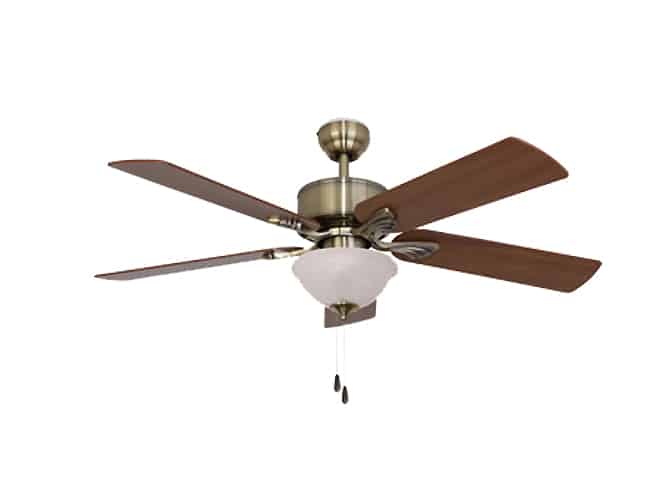By their very nature, ceiling fans are more than great tools to circulate the air–hanging above your room, they also become focal points of your decor. Here’s what you need to know to choose a model that’s perfect for both jobs.
1. The Fan’s Location
The first question is: Are you using it inside or outside? Most ceiling fans are for the interior, but there are some models designed for outdoor use. Such a model will have a UL damp or wet rating, which means that it can be exposed to the elements without sustaining damage like warped blades.
In- or outdoors, fans should be installed no lower than 7 to 8 feet from the floor. For rooms with low ceilings, that means you’ll need a low-profile or “hugger” fan with a close or flush-mount. That will help keep the fan as high as possible.
On the other hand, high ceilings may call for a ceiling fan with a long downrod (that’s the pole that the fan hangs from), which will bring the fan closer to the floor. Sloped ceilings need special treatment with an angle mount and a downrod.
2. Its Style
The electric ceiling fan was invented in 1882, and today, ceiling fans come designed in just about every style that’s been in vogue since then: traditional, Victorian, Asian-inspired, Mission, Craftsman, and contemporary. There are even theme-specific ceiling fans for children’s rooms.
Another style question you should consider is whether you want your fan to do double duty and serve as a light fixture as well.
3. The Ceiling Fan’s Size
You can find a fan to fit just about any space in the home. The key to selecting the right size fan for a room is to match the room’s dimensions to the fan’s blade span, which refers to the size of the fan from blade tip to blade tip.
A 32-inch fan will cover up to 80 square feet; a 42-inch fan, 80-120 square feet; a 44-inch fan, 120-144 square feet, and a 52-inch fan works well for 144 or more square feet. In rooms larger than 300-square feet, you’ll require two or more 52-inch fans to generate sufficient air circulation. And in very small rooms, the fan should be small enough that the blade tips are at least 15 inches from all walls.
4. How Energy Efficient It Is
Energy efficient ceiling fan models with the ENERGY STAR seal of approval can save 20 percent in energy costs. If the fan has a light that is also energy efficient, it will conserve even more. Most ceiling fans also have a reverse motor feature that allows you to adjust the fan during the winter months so that it circulates warm air.
5. How You Turn It On and Off
Rather than operate with pull cords like older ceiling fans, newer models generally feature wall controls that enable you to turn the fan on and off and adjust its speed. Some fans also have a remote control that allows you to make adjustments from anywhere in the room.
Now that you’re armed with all of the facts regarding buying a ceiling fan, you can choose the best model for keeping you cool and comfortable.

